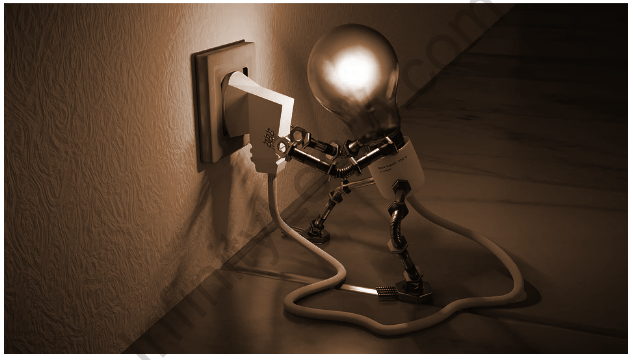Table of Contents

Introduction:
An electrical circuit’s ability to produce work by causing an action is referred to as electrical energy. Thermal, electromagnetic, mechanical, electrical, and other types of activity can be used. Electrical energy can be generated by batteries, generators, dynamos, and photovoltaics, among other things, or saved for later use by fuel cells, batteries, capacitors, or magnetic fields, among other things. As a result, electrical energy can be generated or stored.
The “Law of the Conservation of Energy,” which we learned in elementary school, stipulates that energy cannot be created or destroyed, only converted. However, in order for energy to do any useful work, it must be transferred from one form to another. A motor, for example, turns electrical energy into mechanical or kinetic (rotational) energy, whereas a generator transfers kinetic energy back into electrical energy in order to power a circuit.
That is, through performing work, electrical machines transfer or change energy from one form to another. A lamp, light bulb, or LED (light-emitting diode) is another example of a device that converts electrical energy into light and heat (thermal) energy. Then there’s electrical energy, which can be quickly turned into a variety of other forms of energy.
Work must be done in order for electrical energy to move electrons and produce a flow of current across a circuit. This means that electrons must travel a certain distance through a wire or conductor. The work done is stored as energy in the passage of electrons. As a result, we call the energy-transfer process “work.”
As a result, we can conclude that Work and Energy are effectively the same things because energy is defined as “the ability to accomplish some work.” It’s important to remember that work done or energy transferred applies equally to mechanical and thermal systems as it does to electrical systems. This is due to the interchangeability of mechanical, thermal, and electrical energies.
Electric Power
1 Watt = 1 Joule per second
Electric power definition
Electric power is described as energy produced by converting other sources of energy, such as mechanical, thermal, or chemical energy, into electricity.
- For many applications, such as electricity, computer operation, motive power, and entertainment, electric energy is unequaled. Other applications, such as numerous industrial heating applications, cooking, space heating, and railway traction, are competitive.
- Current, or the flow of electric charge, and voltage, or the potential of charge to provide energy, are the two characteristics of electric power. Any combination of current and voltage values can yield a given amount of power.
- Electronic charge moves in the same direction through the gadget receiving power if the current is direct. The electronic charge goes back and forth in the device and the wires linked to it if the current is alternating.
- Both types of current are acceptable for various uses, but alternating current (AC) is the most generally available because of the greater efficiency with which it can be generated and distributed.
- For certain industrial applications, such as electroplating and electrometallurgical operations, as well as most electronic devices, direct current (DC) is necessary.
Electric Power Formula
The pace at which energy is moved to or from a section of an electric circuit is referred to as electric power. A battery or a circuit part, such as a resistor that releases energy as heat, can deliver energy. The power of any circuit element is equal to the voltage differential across the element multiplied by the current.
If we look at it from the standpoint of Ohm’s Law, we can see that V = IR, indicating that there are different variations of the electric power formula for resistors. Watts are the units of measurement for power.
P=VI
I: Electric current
Then there’s the resistors formula, which combines Ohm’s law with Joule’s law. As a result, we have:
P²=I²/R
=V²/R
P: Electric Power
V: Difference in voltage
I: Electric current
R: Resistance
Power Energy formula
A force that generates a displacement is involved in quantity work. Work has nothing to do with the length of time that this force exerts to cause the displacement. The task is sometimes finished quickly, while other times it is completed slowly. A rock climber, for example, takes an unusually long time to raise her body a few meters up the side of a cliff. A trail hiker, on the other hand, who chooses the simpler path up the mountain, may raise her body a few meters in a short length of time.
Although the two people undertake the same amount of work, the hiker completes it in significantly less time than the rock climber. Power is a quantity that has to do with the rate at which a specific amount of work is completed. The power rating of a hiker is higher than that of a rock climber. The rate at which work is completed is referred to as power. It’s all about the work-to-time ratio. The following equation is used to calculate it mathematically.
P=Work/Time
P=w/t (Watt)
Also read: Important Topic of Physics: Power
Frequently Asked Questions:
What is the definition of an electric charge?
Within an atom, electrons and protons carry an electric charge, also known as an electrical charge. The two forms of electrical charges are positive and negative charges.
What is static electricity, and how does it work?
Electricity is divided into two categories, to be precise. Static electricity is the first. Static electricity is electricity that concentrates in a single location.
What is the definition of an electric current?
Electrical currents are a term used to describe current electricity. Electric currents, also known as current electricity, refer to the transfer of electrical energy from one location to another by means of electron movement.






